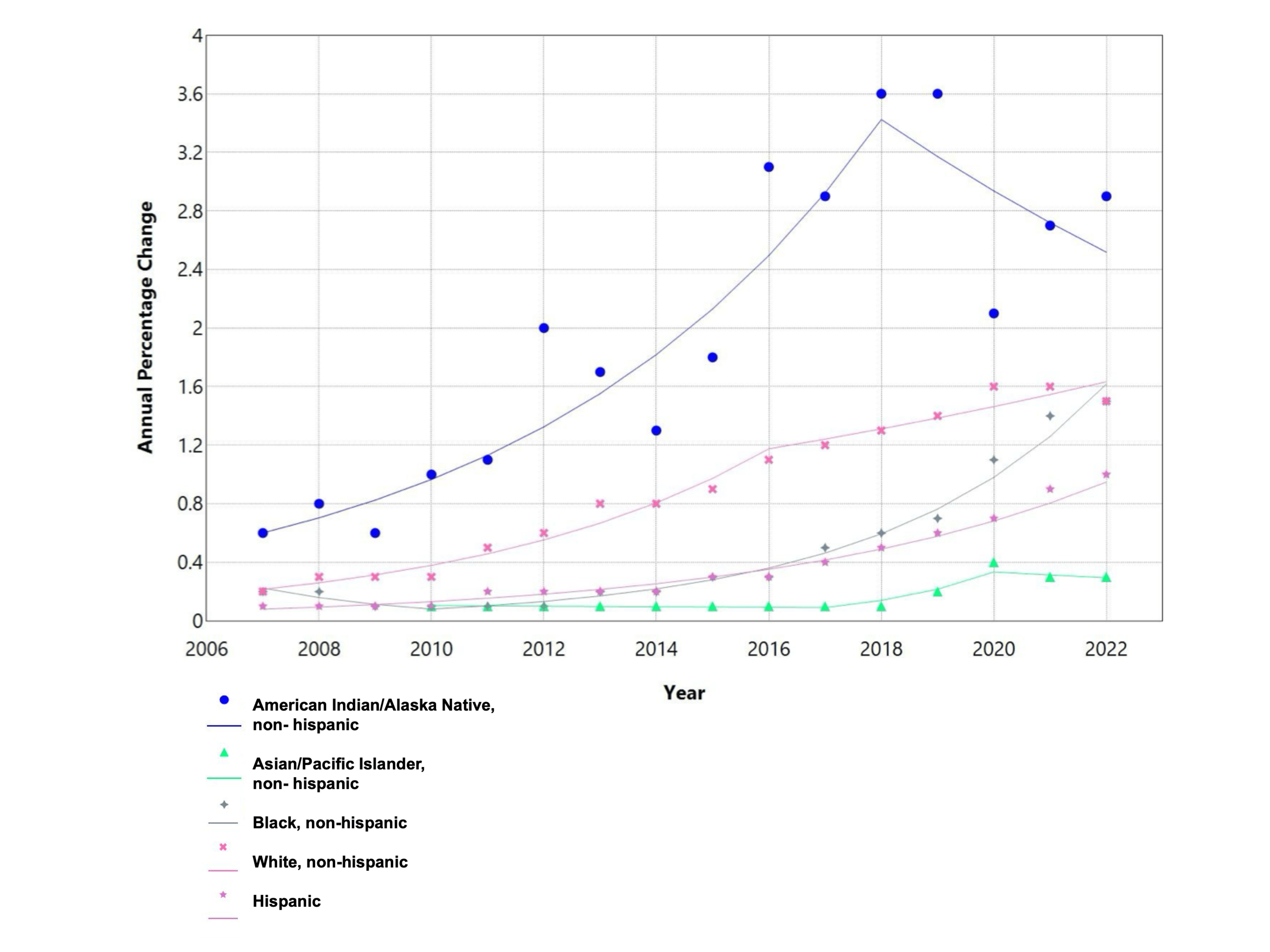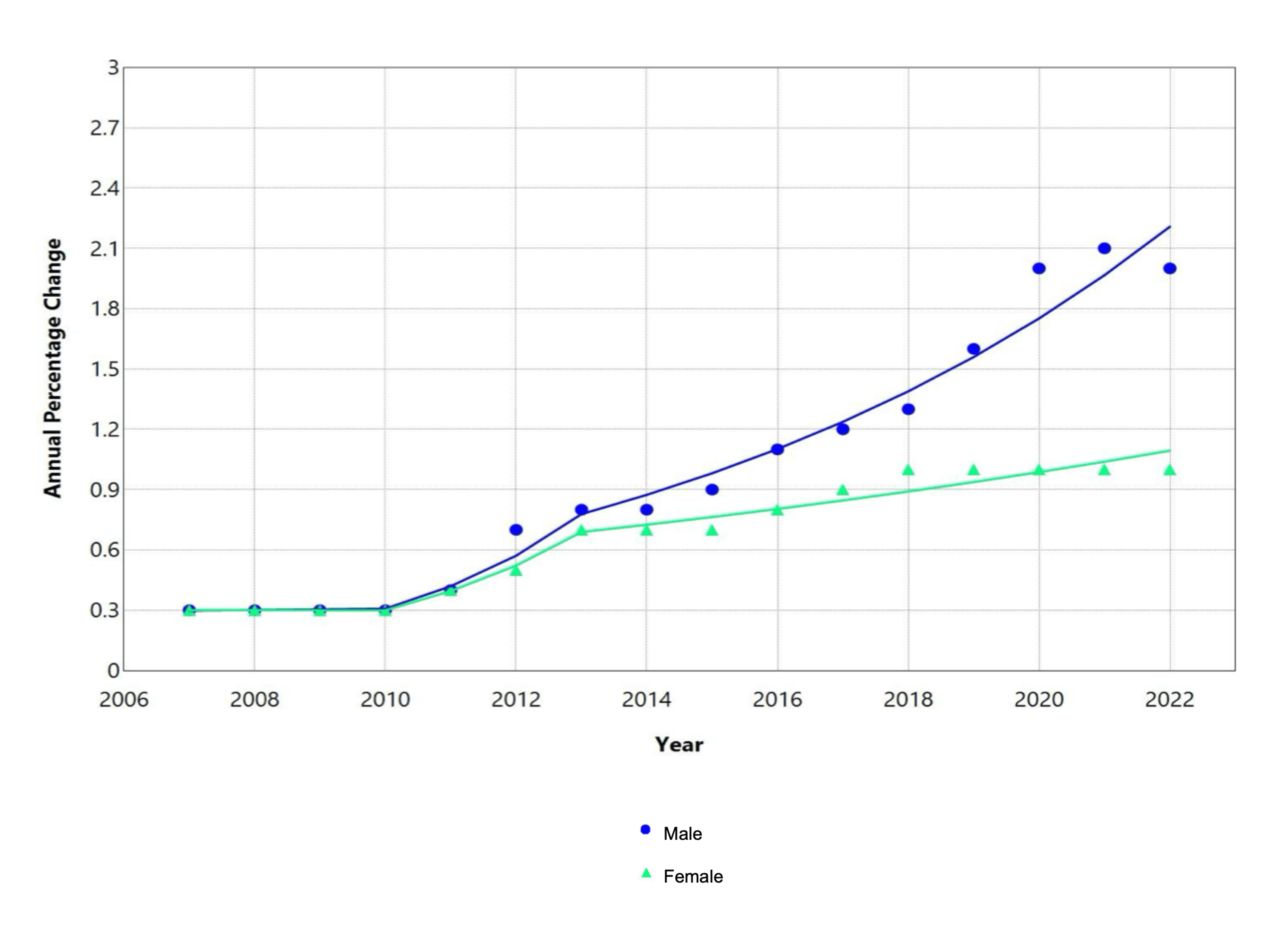Sunday Poster Session
Category: Infections and Microbiome
P1292 - Racio-Ethnic and Sex Disparities in the Incidence of Acute Hepatitis C in the United States
Sunday, October 26, 2025
3:30 PM - 7:00 PM PDT
Location: Exhibit Hall

Rohan Karkra, MBBS
Rutgers New Jersey Medical School
Newark, NJ
Presenting Author(s)
Rohan Karkra, MBBS1, Mohammed Ayyad, MD1, Sameer Rao, MBBS1, Ethan Shamsian, MD1, Menna-Allah Elaskandrany, DO2, Kaveh Hajifathalian, MD1, Ahmed Al-Khazraji, MD1
1Rutgers New Jersey Medical School, Newark, NJ; 2Lenox Hill Hospital, Northwell Health, New York, NY
Introduction: Hepatitis C is a significant global health issue caused by the Hepatitis C Virus (HCV); an RNA virus primarily transmitted through blood-to-blood contact. It often leads to chronic liver disease, including cirrhosis and hepatocellular carcinoma. Approximately 71 million people are chronically infected worldwide. Direct-acting antiviral therapies have revolutionized treatment, achieving cure rates exceeding 95%. This study aims to look at disparities among races and sexes in the incidence of acute Hepatitis C.
Methods: The CDC publishes the National Viral Hepatitis Surveillance reports annually. Data from 2007-2022 is publicly available. These reports were retrieved, and new cases of acute hepatitis C were identified, stratified by race, ethnicity and sex, and reported as cases/100000 persons/year. Time trends were reported as Annual Percentage Change (APC), using the Joinpoint Regression Software (v.5.0.2, NCI) utilizing the weighted Bayesian Information Criteria (BIC).
Results: Compared with 2007, rates in 2022 were substantially higher among all sexes, races, and ethnicities. Non-Hispanic black patients had the highest average APC of 19.58% (95% CI - 13.62, 25.85; p< 0.05), followed by Hispanics at 17.92% (95% CI – 15.88, 20.11; p< 0.05). Non-Hispanic whites had an average APC of 15.07% (95% CI – 12.56, 17.64; p< 0.05), Native American/Alaskans had an average APC of 11.99% (95% CI – 8.15, 15.97; p< 0.05), and Asian and Pacific Islanders had an average APC of 11.43% (95% CI – 5.41, 17.80; p< 0.05). Males had a higher rise in the incidence rates compared to women, with an average APC of 16.13% (95% CI – 14.02, 18.27; p< 0.05) vs 10.44% (95% CI – 8.34, 12.58; p< 0.05).
Discussion: Non-Hispanic black patients and males had the highest average respective APCs, indicating that these populations were showing the fastest increase in the incidence of acute Hepatitis C. Immediate interventions are required to control the rise in acute Hepatitis C.

Figure: Multiple joinpoint models showing annual percentage change of incidence stratified by race

Figure: Multiple joinpoint models showing annual percentage change of incidence stratified by sex
Disclosures:
Rohan Karkra indicated no relevant financial relationships.
Mohammed Ayyad indicated no relevant financial relationships.
Sameer Rao indicated no relevant financial relationships.
Ethan Shamsian indicated no relevant financial relationships.
Menna-Allah Elaskandrany indicated no relevant financial relationships.
Kaveh Hajifathalian indicated no relevant financial relationships.
Ahmed Al-Khazraji indicated no relevant financial relationships.
Rohan Karkra, MBBS1, Mohammed Ayyad, MD1, Sameer Rao, MBBS1, Ethan Shamsian, MD1, Menna-Allah Elaskandrany, DO2, Kaveh Hajifathalian, MD1, Ahmed Al-Khazraji, MD1. P1292 - Racio-Ethnic and Sex Disparities in the Incidence of Acute Hepatitis C in the United States, ACG 2025 Annual Scientific Meeting Abstracts. Phoenix, AZ: American College of Gastroenterology.
1Rutgers New Jersey Medical School, Newark, NJ; 2Lenox Hill Hospital, Northwell Health, New York, NY
Introduction: Hepatitis C is a significant global health issue caused by the Hepatitis C Virus (HCV); an RNA virus primarily transmitted through blood-to-blood contact. It often leads to chronic liver disease, including cirrhosis and hepatocellular carcinoma. Approximately 71 million people are chronically infected worldwide. Direct-acting antiviral therapies have revolutionized treatment, achieving cure rates exceeding 95%. This study aims to look at disparities among races and sexes in the incidence of acute Hepatitis C.
Methods: The CDC publishes the National Viral Hepatitis Surveillance reports annually. Data from 2007-2022 is publicly available. These reports were retrieved, and new cases of acute hepatitis C were identified, stratified by race, ethnicity and sex, and reported as cases/100000 persons/year. Time trends were reported as Annual Percentage Change (APC), using the Joinpoint Regression Software (v.5.0.2, NCI) utilizing the weighted Bayesian Information Criteria (BIC).
Results: Compared with 2007, rates in 2022 were substantially higher among all sexes, races, and ethnicities. Non-Hispanic black patients had the highest average APC of 19.58% (95% CI - 13.62, 25.85; p< 0.05), followed by Hispanics at 17.92% (95% CI – 15.88, 20.11; p< 0.05). Non-Hispanic whites had an average APC of 15.07% (95% CI – 12.56, 17.64; p< 0.05), Native American/Alaskans had an average APC of 11.99% (95% CI – 8.15, 15.97; p< 0.05), and Asian and Pacific Islanders had an average APC of 11.43% (95% CI – 5.41, 17.80; p< 0.05). Males had a higher rise in the incidence rates compared to women, with an average APC of 16.13% (95% CI – 14.02, 18.27; p< 0.05) vs 10.44% (95% CI – 8.34, 12.58; p< 0.05).
Discussion: Non-Hispanic black patients and males had the highest average respective APCs, indicating that these populations were showing the fastest increase in the incidence of acute Hepatitis C. Immediate interventions are required to control the rise in acute Hepatitis C.

Figure: Multiple joinpoint models showing annual percentage change of incidence stratified by race

Figure: Multiple joinpoint models showing annual percentage change of incidence stratified by sex
Disclosures:
Rohan Karkra indicated no relevant financial relationships.
Mohammed Ayyad indicated no relevant financial relationships.
Sameer Rao indicated no relevant financial relationships.
Ethan Shamsian indicated no relevant financial relationships.
Menna-Allah Elaskandrany indicated no relevant financial relationships.
Kaveh Hajifathalian indicated no relevant financial relationships.
Ahmed Al-Khazraji indicated no relevant financial relationships.
Rohan Karkra, MBBS1, Mohammed Ayyad, MD1, Sameer Rao, MBBS1, Ethan Shamsian, MD1, Menna-Allah Elaskandrany, DO2, Kaveh Hajifathalian, MD1, Ahmed Al-Khazraji, MD1. P1292 - Racio-Ethnic and Sex Disparities in the Incidence of Acute Hepatitis C in the United States, ACG 2025 Annual Scientific Meeting Abstracts. Phoenix, AZ: American College of Gastroenterology.

